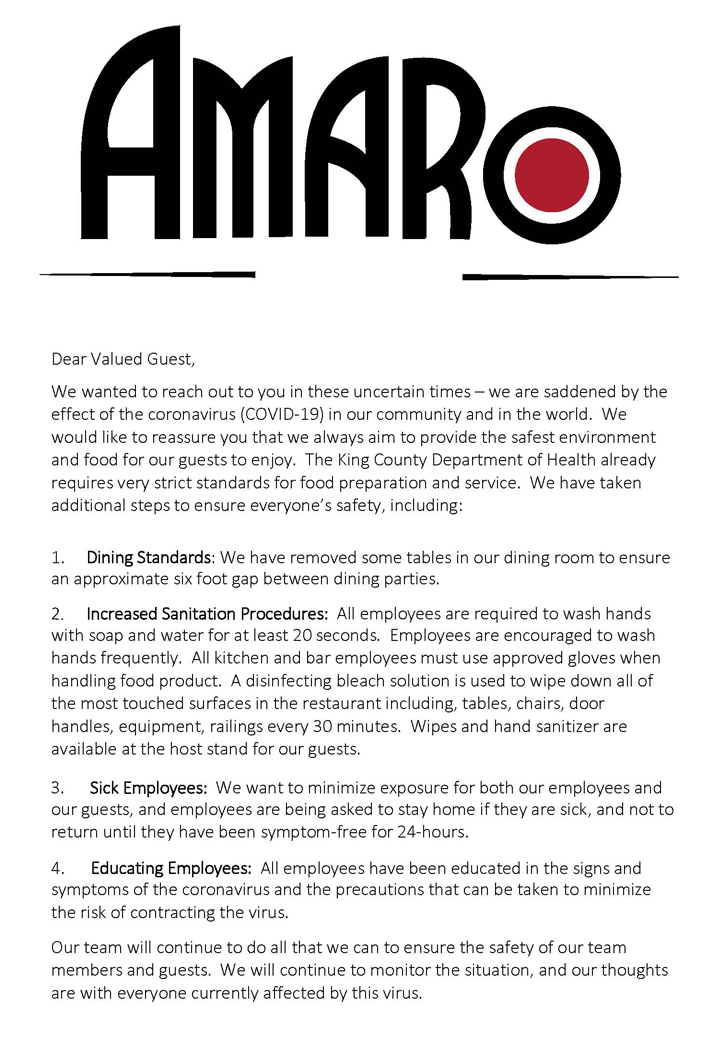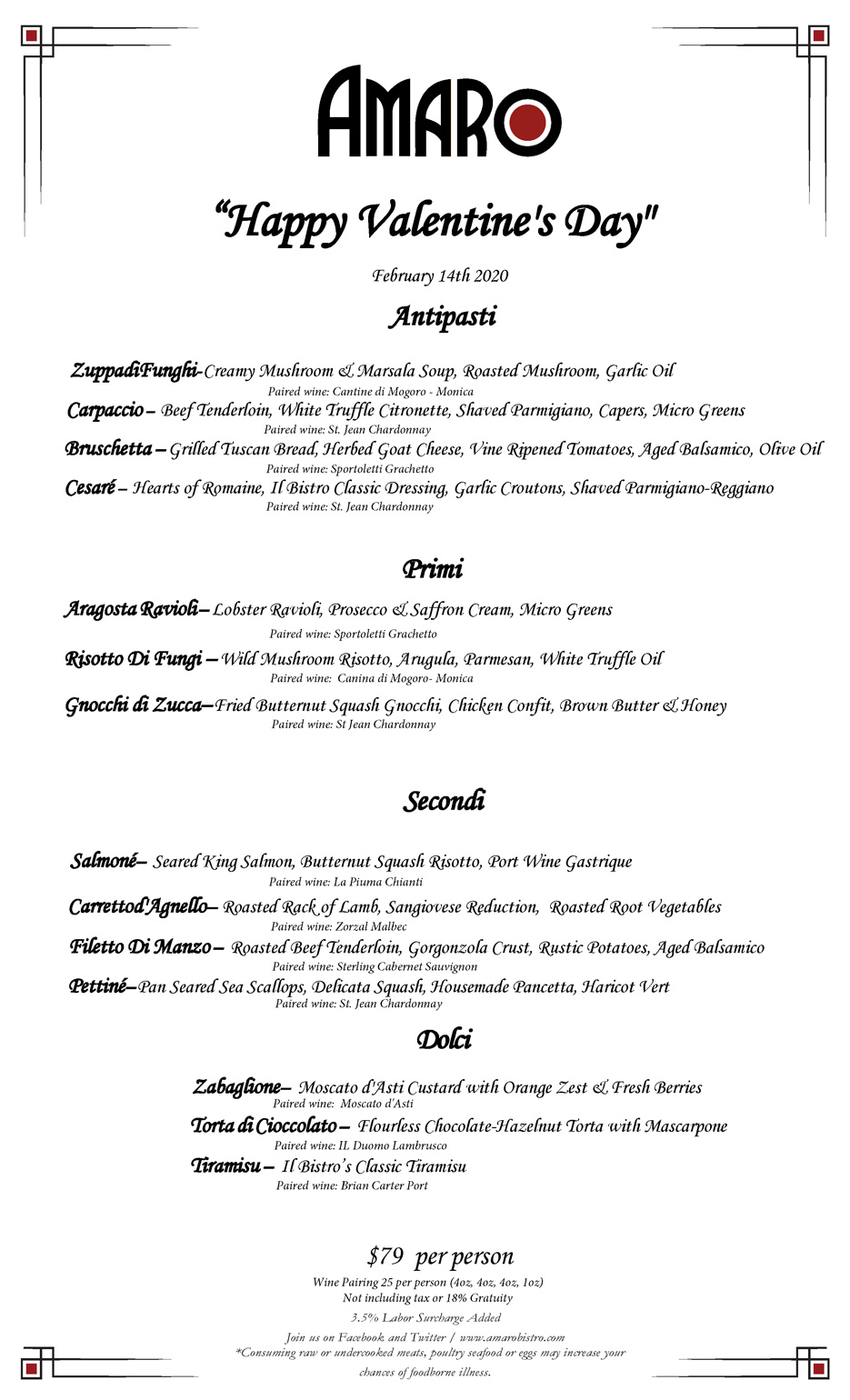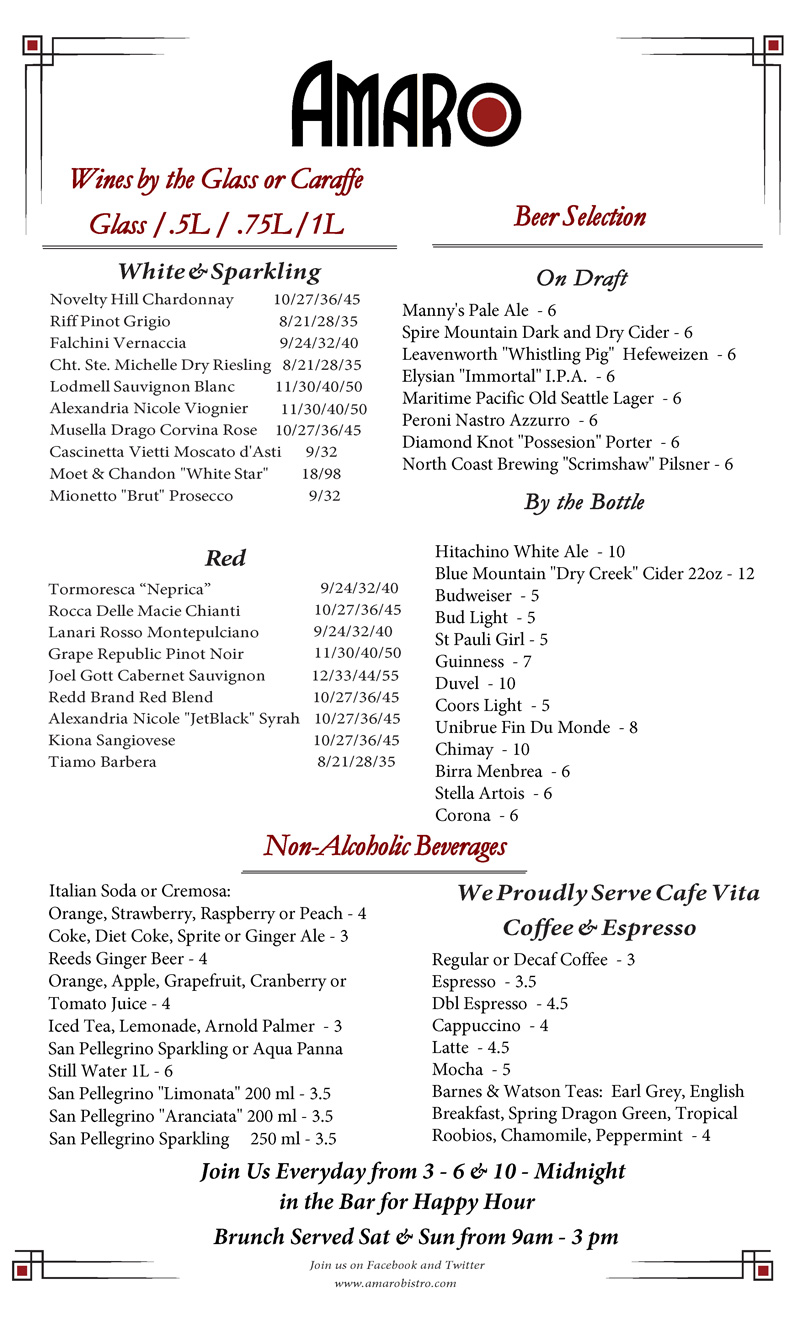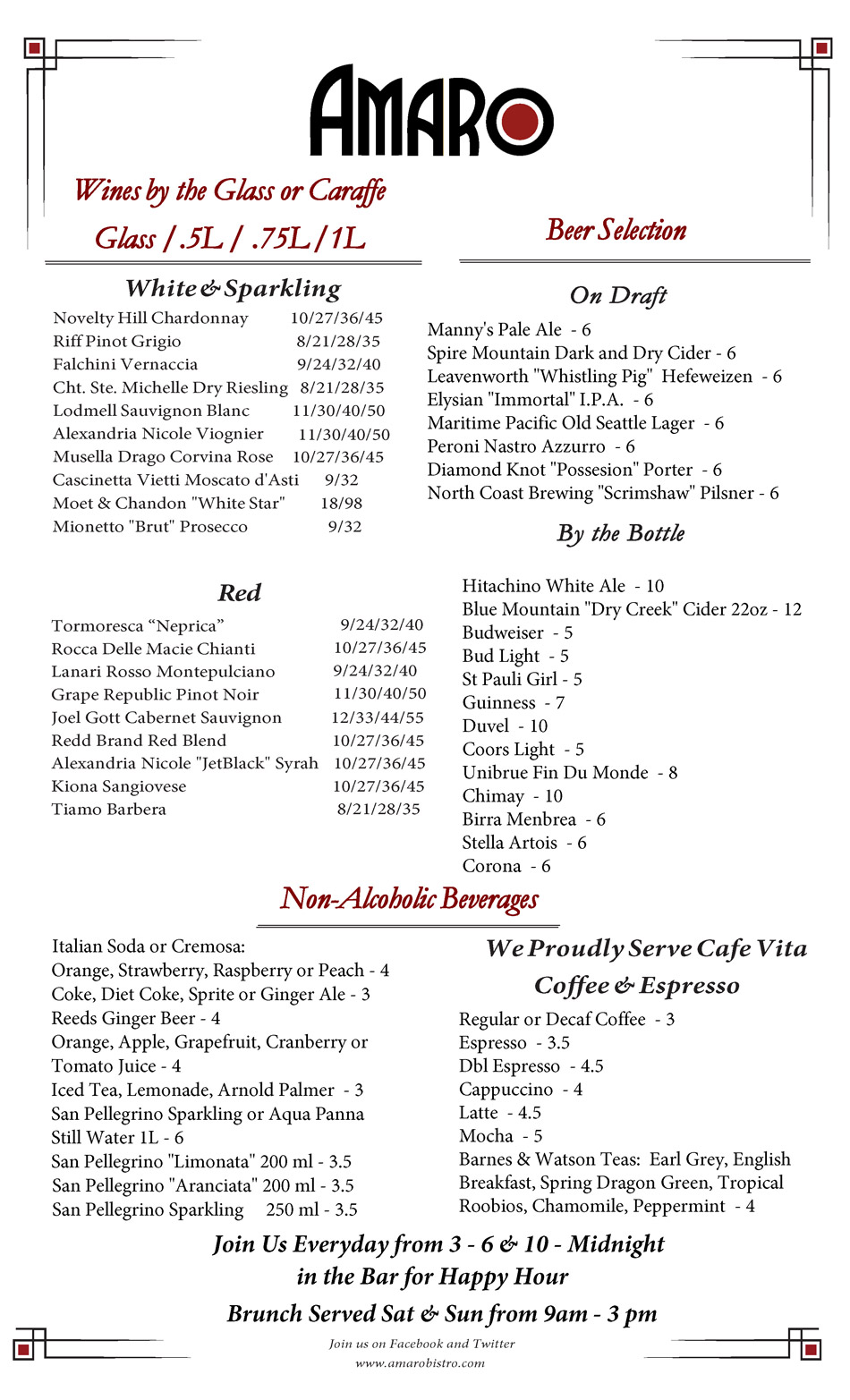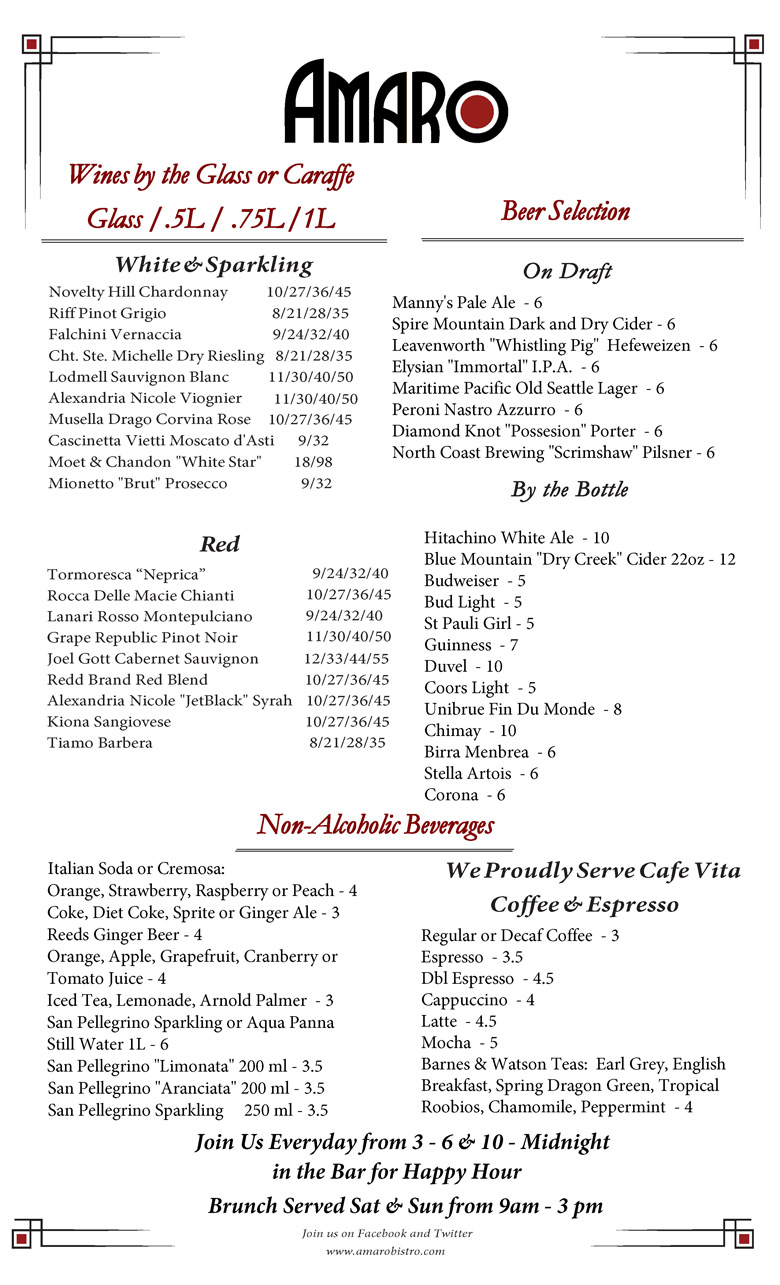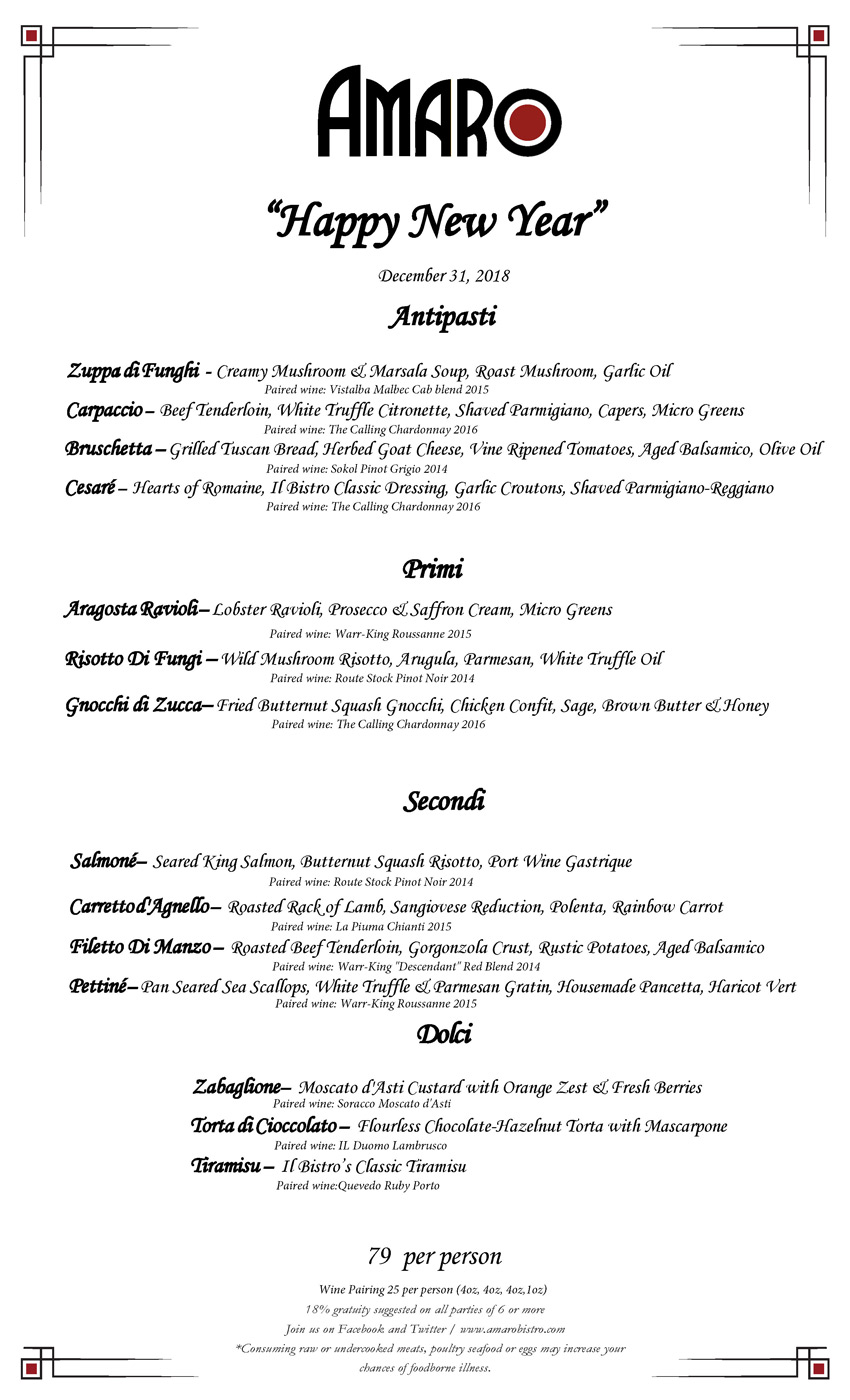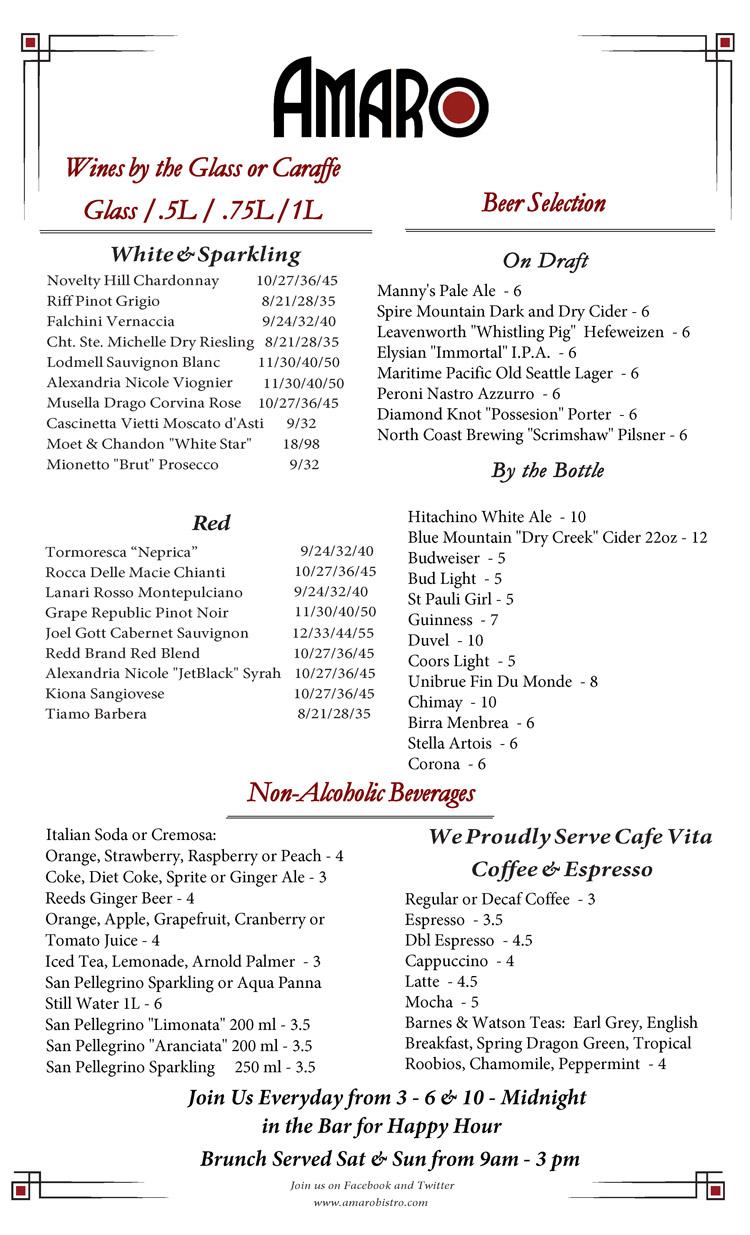This video shows how to properly prepare the Bolognese sauce and the noodles together by our Chef Nathan Luoma.
Category: Blog
Letter to Guests
Valentine’s Day Prix-Fixe Menu
Chef Nathan will be creating a delicious four-course prix-fixe menu with multiple options for each course and an optional $25 wine pairing.
Our regular dinner menu will not be available on this day. We require a credit card to guarantee your reservation. Cost per person is $79
(not including tax or 18% gratuity)
(click to view larger image)
New Year’s Eve Menu 2019
Amaro is offering a Take-out Christmas Dinner!
Christmas Dinner in Italy
This year, Amaro is offering a Take-out Christmas Dinner for 4 people (or multiples of 4)
$135 plus tax. Pre-pay Today!
Dinner Includes:
Insalata Cesare
Romaine Hearts, IL Bistro Classic Dressing, Garlic Croutons,
Shaved Parmigiano
Garlic Bread
Tuscan Bread with Garlic Butter
Lasagne
Traditionally Prepared with Ground Veal & Lamb,
Imported Italian Cheeses, Housemade Marinara.
Served in a beautiful Crate and Barrel casserole dish that you can keep.
Tiramisu
IL Bistro’s Classic Recipe.
Option: One Bottle of Chianti or Cabernet for an additional $20.
La Piuma Chianti DOCG 2017
Or
Sterling “Vintner’s Collection” Cabernet Sauvignon 2015
We provide clear instructions.
You bake the Lasagna and broil the Garlic Bread at your convenience.
Order now and pick up on the morning of December 24th.
Call 425-485-2300 to order!
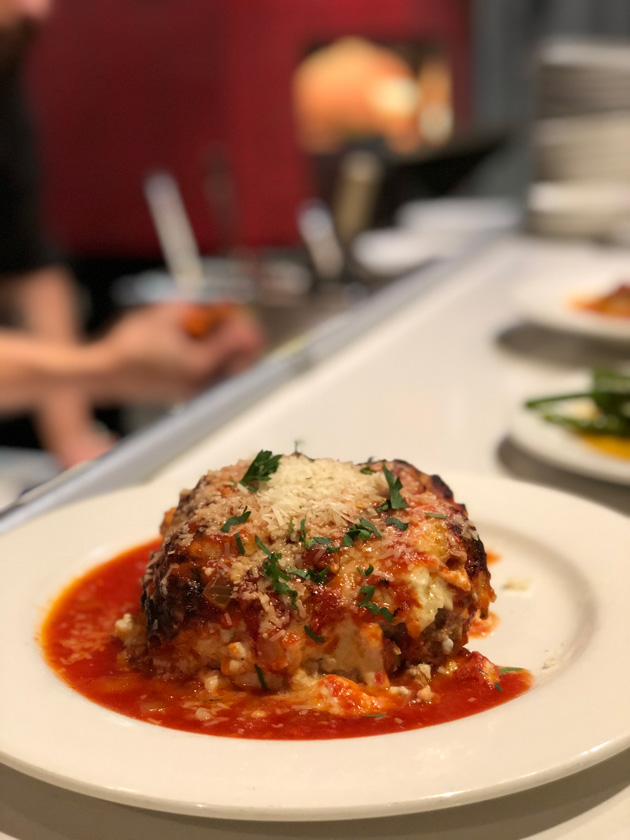
Celebrating our 5th Anniversary! Join us for a special dinner menu.
What You Need To Know About Olive Oil
Basics of Olive Oil To Love
Olive oil is a symbol of Italian food and has been part of the history of Italian cuisine since ancient times. Today, olive oil has become a staple in the pantry of many homes and kitchens, an ingredient many dishes can’t do without. It’s been known for its health benefits and the rich taste it brings to food.
Olive fruits come from a Mediterranean evergreen tree found throughout Italy and the whole Mediterranean basin. When the green olives start to darken or turn black, they are deemed ripe, and ready to harvest. Despite the time-honored tradition of hand picking olives, the sorting and pressing process have been modernized in an effort to save precious time as the fruit spoils easily. The press process is cumbersome and includes grinding and mixing, as well as separating oil from water.
Olive oil is considered “non-filtered” or “cold pressed” as the first, less refined result of olives pressing. Because of its purity and integrity, cold press olive oil is often more expensive than others.
Virgin Olive Oil?
Cold pressed olive oil is also called “virgin” since the oil has not been filtered or modified. Classified as virgin, it cannot contain more than 2% of acidity, refers to the presence of oleic acid, a monosaturated fatty acid. Virgin olive oils are more aromatic than their refined counterparts, with unique taste characteristics associated with their origin.
Extra Virgin Olive Oil
To be considered extra virgin, it must not contain more than 1% acidity. “Ordinary” or “pure” virgin olive oil contains not more than 3.3% acidity. Extra virgin or cold pressed olive oil is the highest quality olive oil available and it is used widely among restaurant chefs. Because of price and quality, this oil is used more sparingly. Extra virgin olive oil is best used over salads or for dipping bread.
Virgin olive oil contains less flavor and aroma than extra virgin, and is best used for frying, grilling and oven roasting. Ordinary olive oil contains even less flavor and aroma than virgin olive oil, and may be used in recipes where flavor from the oil itself is not desired.
Olive oil is not like wine. It doesn’t get better with age. It is a fresh product and must be consumed quickly once the bottle is opened. Olive oil bottles must be kept in a cool, dry storage place, not sun-exposed. Good extra virgin olive oil is very healthy, but it contains a lot of calories. Its fat is better than other kind of vegetable or animal fat, because of its high monounsaturated fatty acids, as well as having antioxidant substances. Olive oil helps lower bad cholesterol and increase good cholesterol.
Healthy Use of Olive Oil in Bothell
Enjoy the richness of olive oil when you dine at Amaro Bistro. Your favorite Italian restaurant in Bothell uses the benefits of this healthy ingredient to bring about authentic, delicious, and classic Mediterranean fare.
Amazing Benefits of Balsamic Vinegar
The Bold, Flavorful, and Healthy Vinegar
Balsamic vinegar is a popular ingredient in salad dressings, marinades, and other foods. It is has a distinctive flavor that is described as bold, tart, and complex. It is a very dark, concentrated, and intensely flavored vinegar originating in Modena, Italy some 900 years ago, made wholly or partially from grape juice. It is simmered to make a concentrate, allowed to ferment, mature for a minimum of 12 years in barrels of progressively decreasing size, made from different woods in order to impart different flavors. The result is a dark, rich and syrupy vinegar to be used very sparingly.
It contains very few calories, is low in sugar, and is fat-free. There are potential health benefits associated with balsamic vinegar. It still needs more research to understand the benefits, but you can feel good about making balsamic vinegar a part of a healthful diet. Here are some health benefits of this popular vinegar.
Balsamic vinegar helps regulate blood sugar when taken as part of a meal. One review found that balsamic vinegar has an antiglycemic impact when consumed, meaning a person’s blood sugar will spike less drastically after a meal. Balsamic vinegar may help lower cholesterol due to its antioxidants that help block toxic cells in the body that can raise cholesterol levels.
Acetic acid in balsamic vinegar contains strains of probiotics that aid digestion. It can help promote good gut health and digestion while supporting overall immune function. The probiotics can also help make a person feel full longer. Some research indicates that people may consume fewer calories throughout the day when they add vinegar to their morning meal.
Other health claims have been made for balsamic. Some research suggested that regularly adding balsamic vinegar to foods could help reduce high blood pressure over time. It can also treat congestion by adding a few drops of vinegar to steaming water and breathe in the vapor. It can help reduce acid reflux or heartburn. It may promote blood circulation as balsamic vinegar is derived from grapes that may help prevent cardiac disease by preventing platelet build-up in blood vessels.
A Little Goes a Long Way in Bothell
Discover fine Tuscan dining in Bothell at Amaro’s and sample some of our flavorful classics, laced with just the right dub of balsamic vinegar to taste. Come dine at Amaro Bistro in Bothell this week!

